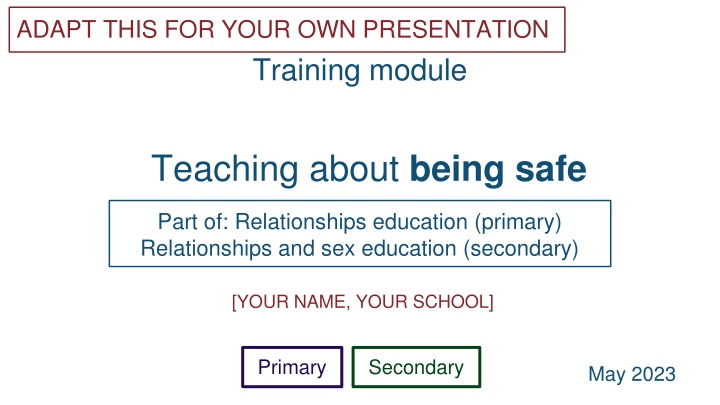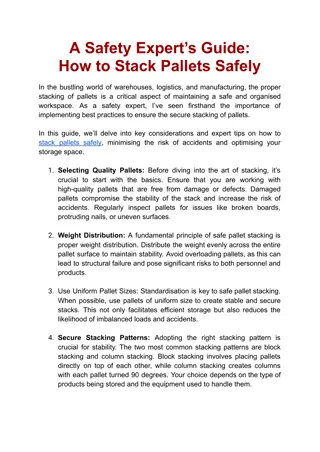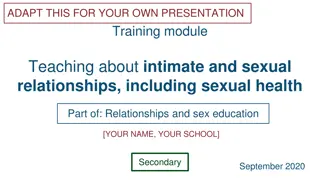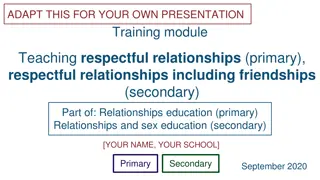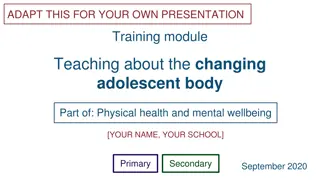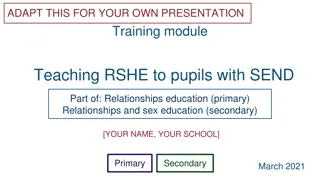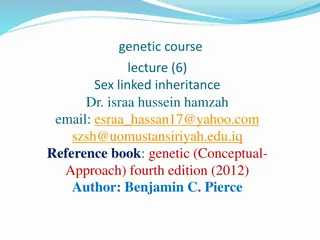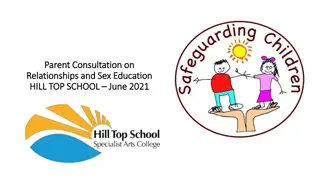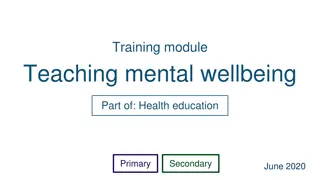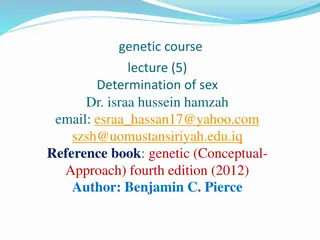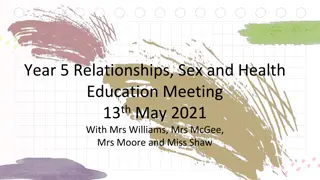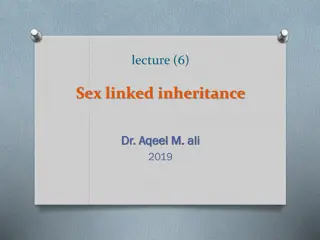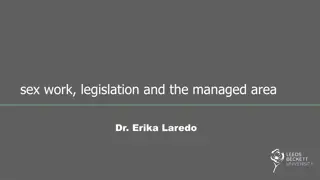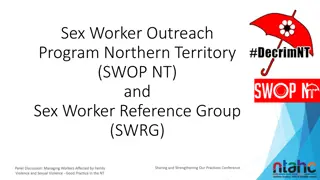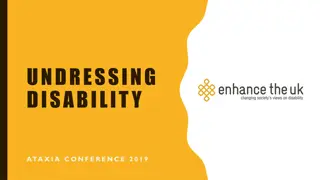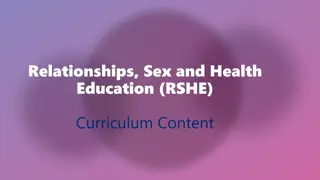Teaching Safely: Relationships and Sex Education Training Module
Enhance your teaching skills with this training module focusing on safety in relationships and sex education. Learn key guidance, facts, and strategies to confidently address this important topic in primary and secondary school settings. Explore related topics and guidance for a comprehensive approach to keeping children safe.
Download Presentation

Please find below an Image/Link to download the presentation.
The content on the website is provided AS IS for your information and personal use only. It may not be sold, licensed, or shared on other websites without obtaining consent from the author.If you encounter any issues during the download, it is possible that the publisher has removed the file from their server.
You are allowed to download the files provided on this website for personal or commercial use, subject to the condition that they are used lawfully. All files are the property of their respective owners.
The content on the website is provided AS IS for your information and personal use only. It may not be sold, licensed, or shared on other websites without obtaining consent from the author.
E N D
Presentation Transcript
ADAPT THIS FOR YOUR OWN PRESENTATION Training module Teaching about being safe Part of: Relationships education (primary) Relationships and sex education (secondary) [YOUR NAME, YOUR SCHOOL] Primary Secondary May 2023
Contents 3 About this training module 5 Teaching the new curriculum 20 Safeguarding 23 Ground rules 26 Primary curriculum 51 Secondary curriculum 122 Examples of good practice 129 Activities and templates for trainers 145 Legal references 2
About this training module Subject leads can use the adaptable slides and activities and templates for trainers section at the end of this module to help shape training sessions for teachers. This non-statutory training module supplements the statutory guidance on teaching about being safe, which schools should read in full. Schools can choose whether and how to follow or adapt this training module and should refer to the Early Career Framework for pedagogical guidance. 3
What you get out of today By the end of this training you should: know what is included in the statutory guidance know some key knowledge and facts to cover as part of this topic have strategies to deal with questions that come up in class feel more confident teaching about being safe 4
Related topics Being safe is closely related to the following topics: respectful relationships (it is good practice to teach this topic first as it provides the framework for good relationships and being safe) internet safety and harms online relationships (primary), online and media (secondary) mental wellbeing Therefore you should: consider thematic links across key topics and the whole school when planning and delivering lessons find ways to link knowledge and vocabulary across topics 6
Related guidance Schools may also want to refer to the following related guidance when planning to teach this subject: Keeping children safe in education Working together to safeguard children Sexual violence and sexual harassment between children in schools and colleges Child exploitation disruption toolkit 7
Support at [school name] Our leads [Names, contact details of first aid leads] Our policies [Add details - e.g. school policy on PSHE, training opportunities] Specialist support [Add details - e.g. providers school already works with] Other information [Add resources] 8
Existing teaching at [school name] Ways in which we already teach about being safe at our school: [Add details] [Add details] [Add details] 9
Helping children to be safe From September 2020 schools must have regard to the new statutory guidance for teaching about being safe. STATUTORY GUIDANCE Through relationships education (and RSE), schools should teach pupils the knowledge they need to recognise and to report abuse, including emotional, physical and sexual abuse. In primary schools, this can be delivered by focusing on boundaries and privacy, ensuring young people understand that they have rights over their own bodies. (p20) 10
Primary and secondary teaching Some slides in this training have a Primary or Secondary label to indicate that the material is usually first introduced in that phase. STATUTORY GUIDANCE Schools have flexibility to design and plan age-appropriate subject content. (p31) Using your knowledge of your pupils and school community you can: introduce secondary content in primary with pupils who need it and are ready teach the primary content in early secondary lessons to pupils who need to build knowledge before secondary content is taught 11
The context for being safe (1) No one should ever experience abuse and there are adults that pupils can trust who will take appropriate and positive action to help them. Be clear about who these adults are. All pupils can benefit from learning the skills needed to build healthy relationships and recognise unhealthy relationships. Schools must be proactive in creating a safe environment where healthy relationships can be built, where pupils facing abuse will be listened to and helped, and where abusive behaviour will not be tolerated. Schools should take care to ensure that pupils continue to feel safe, while being aware of pupils who may already have experienced harm. 12
The context for being safe (2) Primary teaching should introduce the concepts of: personal boundaries privacy, both in person and online what to do if pupils ever feel unsafe This will help to prepare pupils to absorb the more demanding secondary content. Pupils will also be empowered to identify if they are/feel unsafe, and to know where they can access help, from an early age. 13
Managing difficult topics The topics covered in this module could cause distress to some pupils. You should manage this distress by: judging the most appropriate timing and sequencing of the teaching to ensure pupils are not overwhelmed and do not lose sight of the positive and healthy relationships they will build and experience throughout their lives (see slide timing and sequencing these topics in this module) teaching about healthy relationships before discussing more difficult topics highlighting ways to get help whenever difficult topics are discussed Good practice 14
Timing and sequencing these topics To ensure that the content of this module is not overwhelming for pupils, schools should phase the delivery of the topics and assess what level of detail to teach. Teachers will need to take into consideration age and developmental appropriateness for their pupils, so that they are not lacking the knowledge they need to make informed decisions if they encounter issues described in this module. Teachers should not deliver this content in one unbroken series of lessons and should consider delivering parts of this module in conjunction with modules such as intimate and sexual relationships , online relationships , internet safety and harms , caring friendships , Good practice respectful relationships and mental wellbeing . 15
LGBT needs and inclusion Primary schools are enabled and encouraged to cover LGBT (lesbian, gay, bisexual and transgender) content if they consider it age appropriate to do so. Secondary schools should include LGBT content. When doing so, schools should ensure: LGBT-relevant knowledge and examples are included throughout programmes of study (not one-off teaching) inclusive language is used, considering how individual pupils may relate to particular topics 16
Pupils with SEND You will need to plan lessons to allow all pupils to access and practise the core knowledge, using your expertise as you normally would. You might want to link lesson outcomes with statutory preparing for adulthood outcomes for those with an education, health and care (EHC) plan. (See SEND code of practice, section 8.) STATUTORY GUIDANCE In special schools and for some SEND pupils in mainstream schools there may be a need to tailor content and teaching to meet the specific needs of pupils at different developmental stages. As with all teaching for these subjects, schools should ensure that their teaching is sensitive, age-appropriate, developmentally appropriate and delivered with reference to the law. (p15) 17
Teacher wellbeing The new curriculum covers a wide range of topics, some of which individual teachers might find personally challenging in different ways. It is important to feel you can ask for support or raise questions if: you have personal experience of a topic which makes teaching that content particularly challenging for you you have personal views on a topic that mean you need to discuss how you can ensure the teaching is delivered objectively Talk to your line manager, in the first instance, if you do need support. 18
References to the law The references to the law both within and at the end of this module are given as a teacher resource if needed. They are not exhaustive. Teachers are not expected to be able to teach the details of the law or to be able to answer complex questions that may come up about the law. If pupils have specific legal questions they should be directed to appropriate sources of information and advice. Teachers are not qualified to give legal advice. 19
Safeguarding 20
Safeguarding (1) Pupils may be affected by issues discussed in lessons. Let your designated safeguarding lead or deputy and any other relevant staff, such as pastoral leads, know what you are teaching. This will enable them to identify and speak to relevant pupils, especially those who they know may have been directly impacted by issues covered in the lessons and those with adverse childhood experiences. Teachers may need to deal with disclosures or concerns (e.g. of abuse or offending behaviour) in a way that safeguards pupils in line with school policies, especially the child protection policy. 21
Trusted adults Within this module we have used the term trusted adult. A trusted adult will generally be someone who children feel comfortable to turn to for help. Obvious examples include family members, teachers and doctors. It will be important when teaching this topic, and any other relevant topics, that teachers explore this concept. Pupils should be comfortable and capable of identifying who their trusted adults could be, both within their families and wider circles. 22
Ground rules 23
Create class ground rules Clear class ground rules can help when teaching about sensitive topics. They also support confidentiality and safeguarding of pupils. Good practice is for ground rules to be: discussed and understood by all clear and practical modelled by the teacher followed consistently and enforced updated when needed visible in lessons (for example, posters) 24
Example ground rules Respect privacy. We can discuss examples but do not use names or descriptions that identify anyone, including ourselves. Listen to others. It is okay to disagree with each other, but we should listen properly before making assumptions or deciding how to respond. When disagreeing, challenge the statement not the person. No judgement. We can explore beliefs and misunderstandings about a topic without fear of being judged. Choose level of participation. Everyone has the right to choose not to answer a question or join discussion. We never put anyone on the spot (no personal questions or pressure to answer). 25
Subjects covered by the primary slides The content is divided into the following sections for ease of reference: boundaries, privacy and feeling unsafe asking for help and support 27
Respectful, positive relationships STATUTORY GUIDANCE Know what sorts of boundaries are appropriate in friendships with peers and others (including in a digital context). Teaching about being safe must always take as its starting point respectful, healthy, positive relationships. Children need to be able to recognise these and recognise their right to be respected, before they can recognise unsafe relationships. Discuss some characteristics of a positive: friendship, e.g. enjoying time together family relationship, e.g. love and trust relationship with someone else, e.g. feeling supported by a teacher Primary 29
Appropriate boundaries (1) STATUTORY GUIDANCE Know what sorts of boundaries are appropriate in friendships with peers and others (including in a digital context). Embed learning from respectful relationships on respecting boundaries between friends. Explain that it is important to know our own boundaries in friendships, and with others, both offline and online. This includes having appropriate boundaries around: physical contact (including how much and what kinds of contact we have with different people) personal information (including what information we share, and what we keep private) Primary 30
Appropriate boundaries (2) STATUTORY GUIDANCE Know what sorts of boundaries are appropriate in friendships with peers and others (including in a digital context). Explain that individuals have personal boundaries and that these differ by situation (e.g. at school or online) and between people (e.g. with close friends or others). Teach pupils how to: communicate their boundaries recognise and respect other people s boundaries keep some information private, including online ask for support from a trusted adult if someone does not respect our boundaries Primary 31
Communicating boundaries STATUTORY GUIDANCE Know what sorts of boundaries are appropriate in friendships with peers and others (including in a digital context). Teach pupils that while other people should not make assumptions about our boundaries we can also communicate our boundaries by: telling or showing people how we feel about things (e.g. which toys we are happy to share, whether we prefer to greet friends by saying hello, hugging or in another way) telling a trusted adult if someone does not respect our boundaries Explain that we all have a right to maintain our boundaries both offline and online and that it is ok to say no (for example). Primary 32
Recognising boundaries STATUTORY GUIDANCE Know what sorts of boundaries are appropriate in friendships with peers and others (including in a digital context). Teach pupils that, whilst some of their boundaries might be similar to others , recognising and respecting other people s boundaries is an important part of friendships and other relationships and can make them happier. This means: not assuming that everyone wants to be treated in the same way listening to our friends if they tell or show us that they are uncomfortable Remind pupils that when people feel under pressure (put on the spot) they might say they are happy with something when they are not. Primary 33
Keeping some information private STATUTORY GUIDANCE Know what sorts of boundaries are appropriate in friendships with peers and others (including in a digital context). Teach that people also have boundaries about the information they share. We have a right, for example: not to share personal information with someone online to only talk to the people we choose (e.g. a close friend or trusted adult) about some issues Remind pupils that if they or someone they know is keeping information private that worries or upsets them, they have a right to talk to a trusted adult about it. Primary 34
Privacy STATUTORY GUIDANCE Know about the concept of privacy and the implications of it for both children and adults; including that it is not always right to keep secrets if they relate to being safe. Teach that children, young people and adults have a right to privacy, which may include: having some times or spaces where others do not see us (e.g. when using the toilet or dressing) having some things that other people do not know about us (e.g. our personal details) Explain that sometimes trusted adults need to check a child is safe or know things (including secrets) in order to keep them safe. Primary 35
Secrets STATUTORY GUIDANCE Know about the concept of privacy and the implications of it for both children and adults; including that it is not always right to keep secrets if they relate to being safe. Explain that sometimes secrets can be fun (e.g. a surprise party). However, we do not have to keep secrets that make us feel worried or uncomfortable. Explain that pupils can: ask a trusted adult for advice if a secret makes them feel scared, embarrassed or uncomfortable encourage a friend to speak to someone or call Childline anonymously if they are keeping a strange or worrying secret This applies even if an adult or another young person has asked for something to be a secret. Talking to a trusted adult could keep someone safe. Primary 36
STATUTORY GUIDANCE Know that each person s body belongs to them, and the differences between appropriate and inappropriate or unsafe physical, and other, contact. Rights over our own bodies (1) Recognise that for some pupils physical contact with others can be a good thing. Holding hands with or hugging people we like and trust can be positive and reassuring. Teach that everyone s body belongs to them. For older pupils introduce the concept of bodily autonomy . Wherever possible an individual s physical boundaries should be respected. No one should do anything to someone else s body to make them feel uncomfortable. Ensure that children are able to name body parts and are aware of which parts are considered to be private. Primary 37
Rights over our own bodies (2) STATUTORY GUIDANCE Know that each person s body belongs to them, and the differences between appropriate and inappropriate or unsafe physical, and other, contact. Emphasise the wonders of our bodies, and be clear that our bodies belong to us. Teach that people have a right to: choose whether we have physical contact, like holding hands or hugging refuse some contact, e.g. saying no or that makes me uncomfortable , or indicating in another way in words, with a facial expression or with our body change our mind about physical or other contact at any time Primary 38
Rights over our own bodies (3) STATUTORY GUIDANCE Know that each person s body belongs to them, and the differences between appropriate and inappropriate or unsafe physical, and other, contact. Explain that an adult or another young person should never make a young person uncomfortable, e.g. by: touching them inappropriately touching them in a way they do not agree to asking them to share or look at an inappropriate image (e.g. a partly or fully naked picture) Primary 39
Rights over our own bodies (4) STATUTORY GUIDANCE Know that each person s body belongs to them, and the differences between appropriate and inappropriate or unsafe physical, and other, contact. Explain that pupils can: ask a trusted adult for advice if physical contact ever makes them feel scared, embarrassed or uncomfortable encourage a friend to speak to someone or call Childline anonymously if they are worried about physical contact they have experienced Refer to the slides on asking for help and support for more guidance. Primary 40
Responding to adults STATUTORY GUIDANCE Know how to respond safely and appropriately to adults they may encounter (in all contexts, including online) whom they do not know. Teach that children have the right to: deny or withdraw permission from adults or other young people who make them feel uncomfortable or unsafe to have contact with them in person or online speak to a trusted adult if an adult or another young person makes them feel unsafe, sad, worried or embarrassed Primary 41
Being safe STATUTORY GUIDANCE Know how to recognise and report feelings of being unsafe or feeling bad about any adult. Teach that all people, including children, have a right to feel safe. For example, feeling safe can mean: feeling cared for by our family knowing we will have enough food when we need it for some pupils, positive, reassuring touch Primary 42
Feeling unsafe STATUTORY GUIDANCE Know how to recognise and report feelings of being unsafe or feeling bad about any adult. Teach pupils to trust how they feel to help recognise feelings of being unsafe or feeling bad about any adult or other young person. Explore examples of behaviour that can make people feel unsafe, include examples from previous slides in this module. Add that being shouted at a lot with hurtful words, or told to say bad things about someone else might also make them feel unsafe. Primary 43
Recognising abusive behaviour (1) STATUTORY GUIDANCE Know how to ask for advice or help for themselves or others, and to keep trying until they are heard. Embed learning from respectful relationships and discuss the characteristics of positive relationships to enable pupils to contrast positive and negative behaviour. Begin to introduce the concept of abuse (covered in more detail in secondary) so that pupils: can recognise the signs that something is wrong know when they need to get support Primary 45
Recognising abusive behaviour (2) STATUTORY GUIDANCE Know how to ask for advice or help for themselves or others, and to keep trying until they are heard. In particular, explain that a pupil can seek help if: someone is harming them in any way someone makes inappropriate physical or other contact with them they are worried or upset about how anyone is treating them (including online) Explain that there are laws against abuse and it is important to report concerns or ask for help if we or someone we know is being abused. Explain that it is never wrong or rude to do something to keep ourselves or someone else safe. Primary 46
Right to ask for help STATUTORY GUIDANCE Know how to ask for advice or help for themselves or others, and to keep trying until they are heard. Teach that children have a right to feel safe. If an adult hurts a child in any way, or makes them feel uncomfortable or unsafe, then the adult is doing something wrong. It is never the child s fault. Explain that we can also ask for help if another child is hurting us, or making us feel uncomfortable or unsafe and that: speaking up is not telling tales and shows courage people can speak up for themselves or for someone else we do not have to keep secrets that worry us Speaking to a trusted adult is a good way to get support. Sometimes an adult will be able to manage an issue, find someone else to help, and reassure us. Primary 47
How to ask for advice STATUTORY GUIDANCE Know how to ask for advice or help for themselves or others, and to keep trying until they are heard. Teach that we can ask a trusted adult for help in any way, e.g. by saying things like: can I tell you something? I need your help. I feel worried, confused... I am scared for [a friend] this lesson made me think about when Teach that adults should listen to and take children s feelings and experiences seriously. If a child is not listened to or understood they should ask others for help. Remind pupils of school processes and the people they can speak to outside the classroom. Primary 48
How to talk about concerns STATUTORY GUIDANCE Know how to report concerns or abuse, and the vocabulary and confidence needed to do so. Explain that it can be hard to talk to people when we are worried or hurt by something. Teach that children can use any way of communicating that feels right to them, e.g. speaking, writing it down, drawing a picture, or referring to a TV programme. Examples of what someone could say include: this person is doing... and I don t like it I feel worried, scared, bad when... this person makes me feel [sad, embarrassed] someone touched me and I felt uncomfortable Ensure pupils have the vocabulary to report accurately any concerns about inappropriate touching or abuse. Primary 49
Where to get advice STATUTORY GUIDANCE Know where to get advice e.g. family, school and/or other sources. Teach pupils to identify who they can go to for advice if they feel unsafe or need to talk. This could include: adults in their family (immediate and extended), or other adults they feel safe with (e.g. teachers and other staff, GP, a friend s parents) a range of support services (national and local) Childline anonymously Remind pupils that if someone is in immediate danger we can call the police ourselves on 999. Explain that talking to a friend can often help but that children do sometimes need support from an adult to deal with difficult problems and worries. Primary 50
